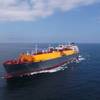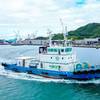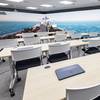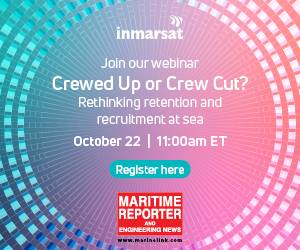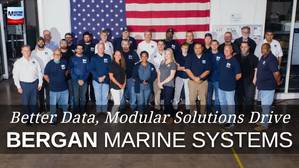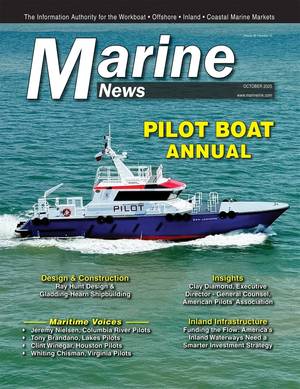Can the Hinge Ship Work?
This arrangement, according to its designer John H. Leary, P.E., of Leary Engineering in New Orleans, allows the two separate port and starboard hulls to rotate relative to each other and thus alter, for a given displacement, the vessel's waterplane area and draft.
Applications for the concept include dry bulk cargo, liquid bulk cargo, trailers and military vehicles. The "Hinge" The rotation of the two hulls about the hinge is accomplished by using the beam and gear mechanism. This operation is greatly assisted by using water ballast in the double bottom spaces under the cargo compartments. Each double bottom is divided by a watertight longitudinal bulkhead at its center. Because the forces encountered in inland waters are relatively small, the hinges and beams alone are able to resist relative movement between the two hulls. However, the vessel's two hulls are brought together in the deep-draft configuration before it goes to sea. This engages the aligning devices (pyramids and sockets), which along with the beams and hinges, resist the longitudinal and vertical forces encountered at sea. Additional analyses confirmed the ability of the hinges to resist hull torsion at sea. The materials selected for the hinges and bearings are resistant to corrosion and binding. Economies of Scale The advantages of owning and operating a vessel, which could readily transform from a deep draft configuration to a shallow draft arrangement are rather obvious in terms of savings of time and money. While the jury is still out regarding a potential owner/operator's view on having a hinge on its vessel, with all of the safety and maintenance questions that come with it, Leary presents a strong case for a radical design, which could well fit the transportation bill of future generations. For example, the vessel offers economies not only to the owner operation, but also the shipbuilder, as the design concept can be built using barge building techniques at relatively small shipyards.
The design calls for a deck, bottom and shell consisting almost entirely of stiffened flat plate and chines. The bow and stern are raked and resemble river barge rakes when the vessel is in its shallow draft mode. However, these rakes are shaped so that the bow and stern more closely resemble those of a ship's seagoing form when the vessel is in its deepdraft mode. these features are evident in the drawings of the vessel and in the photographs of the model. The Initial Design Drawings depicted throughout the ensuing pages depict a vessel of both a self-propelled (ship) and non-self-propelled (barge) version. The initial offering is of a vessel that would be suitable for the Mississippi River system, but should be duly noted that they are transferable for other dimensions and proportions as well. The principal dimensions of the prototype Mississippi River system vessel are: Length 595 ft. (181.3 m) Breadth 105 ft. (32 m) Draft (inland) 13 ft. (3.96 m) Draft (ocean) 28 ft. (8.5 m) Cargo (ship) 12,400 long tons Cargo (barge) 13,200 long tons The vessel is capable of carrying additional cargo in its ocean configuration as follows: Draft 34 ft. (10.4 m) Cargo (ship) 21,000 long tons Cargo (barge) 21,800 long tons The 595 x 105 ft. (181.3 x 32 m) dimensions noted above - selected for a vessel operating on the Mississippi River system - are equivalent to nine (3x3) standard 195 x 35 ft. (59.4 x 10.6 m) or 200 x 35 ft. (60.9 x 10.6 m) river barges. The ship version is designed to navigate anywhere a tow of nine barges can navigate. Either the barge or the ship versions can be placed in a tow of standard barges being pushed by a standard towboat. The vessel's dimension also allows it to transit existing locks on the Mississippi inland river system. In addition, standard ocean tugs can tow the barge version at sea, and of course, the ship version can sail under its own power.
Main propulsion machinery is designed to consist of electric Z-drive units, one port, one starboard. The steerable units, complete with propeller nozzle, would provide the maneuverability need in shallow drafts as well as the propulsive force needed in deepdraft mode. The electric motors are designed to be located in the aft machinery flat above the Z-drive units. In either draft condition, the propellers are above the baseline protected from damage by grounding. This propulsion system combined with the stern hull shape eliminates the need for flanking rudders. The Many Modes of Hinge-Ship Hinge-Ship is designed as a multi-functional and convertible vessel, which will help ship owners and operators meet a variety of needs in a safe, efficient and cost-effective manner. The following are details of the vessel types designed to date. Dry Bulk Carrier Each cargo hold has a large hatch with hydraulic operated hatch covers. In deep draft condition, the hatch openings are parallel to baseline and fully accessible for standard loading and unloading elevator equipment. In shallow draft mode, the inboard hatch coaming is sloped somewhat increasing the clear hatch opening. Loading the vessel in this condition is accomplished using standard grain elevator loading equipment. In this version, the aft house remains parallel to baseline while changing draft configurations. This allows ship's personnel to continue their operating duties without experiencing irregular deck movement. Trailer Transport The general hull design, propulsion and operating advantages are identical to that of the bulk cargo ship. The hold deck and the 'tween deck provide trailer stowage, separated by watertight transverse bulkheads. The hold deck has eight rows of trailers. Each row of trailers is positioned by deck guide rails located between dual tires. The hold deck and tween deck provide trailer stowage, separated by watertight transverse bulkheads. The tween deck has four rows of trailers throughout the cargo area, also separated by watertight transverse bulkheads.
Trailers are driven (using a special handling tractor) on the vessel via the side ramp into the positioning area where each trailer is aligned and backed into one of the rows. In ocean service, when the stowage decks are angled, the trailers are secured from athwart ship movement by means of mechanical jacking clamps. The jacks are aligned at the trailer bed and at the trailer top. Individually the trailers are positioned, and secured. Fore and aft movement is restrained by standard cargo lashing from deck fittings to trailer bed at both ends of the trailer. Military As a military transport, the vessel is capable of carrying a variety of rolling vessels and offers the advantages of trans-oceanic transportation with shallow water bow unloading. Beach landings are possible in the shallow draft condition, with side ramps port and starboard for loading and unloading. A standard compartmentized ballast system provides the needed trim for beach approach, and subsequent withdrawal. Welcome "LoJack" For Ships Epic proportions of automobile theft in the United States led to the creation a few years ago of an innovative product dubbed Lo-Jack, which is essentially a hidden transmitter placed in the vehicle which, when activated by a call of a stolen vehicle to the police, allows them to track the vehicle rather quickly. The same concept was recently rolled out for ships, particularly targeting owners operating vessels in areas of high piracy activity.
Piracy is a serious threat to ships and the personnel that crew them. With pirating activities running rampant in some parts of the globe - particularly the Far East - organizations from the International Maritime Organization (IMO) on down are devising means and methods to keep ship and crew safe.
CLS, a satellite-based company believes it has the product - one that relies on high-tech electronics and satellite communications - to help locate and recover ships in the event of a hijacking. The company has therefore created Shiploc, a new device developed in conjunction with the International Maritime Bureau (IMB), which is a major component in the fight against these acts of violence on the high seas. This small device, which is the approximate size of a shoebox can easily be hidden anywhere on a ship. Installed per the vessel's owner, who can track its position at any time via Shiploc, the system is unbeknownst even to the ship's master and crew for extra precaution. Since, according to P.K. Mukundun, IMB's director, "a vessel can move up to 15 positions a day," the owner can track its movement with Shiploc via Internet access on a personal computer.
While the number of pirate attacks, according to the IMB has declined during the last year, it has also been reported that there is a steady rise in crewmembers being injured or killed during these attacks.
Available in both normal and crisis mode, Shiploc allows vessel owners to track the positions of their ships through the Web site. Using a confidential user name and password, owners log on to the site, and are able to check the whereabouts of their vessels through a clear and concise map plotting each position through the device's dedicated software called Elsa. When set in normal mode, Shiploc can also alert owners through both e-mail and the Web site as to whether their vessel arrived safely at its expected destination. If the owner logs on and finds that his vessel has gone off course, he can then kick the system in to crisis mode, which will alert IMB's Kuala Lumpur headquarters of a possible hijacking. . Once data is received by IMB's piracy reporting center, the Bureau, after accessing the ship's position data, will inform the local law enforcement agencies and coordinate all necessary action to ensure the safety of the crew and the vessel's recovery.
Running on the ship's power supply, Shiploc includes its own back up for extra protection, in case the vessel's power is cut off during a hijacking. Despite a power shutdown, a vessel equipped with the safety system will still be able to send data via the transmitter. Shiploc is designed specifically for the maritime industry, and is available to owners for $280 a month including cost of satellite messages. Mukundun reports that so far more than 60 units have been installed on various types of vessels internationally, and are continuing to climb steadily on a consistent basis. Internet@Sea
Barriers to communication between ship-to-ship and ship-to-shore are quickly dissolving with the break-neck speed at which the communications industry worldwide is expanding capabilities and service. Cruise ships - which cater to millions of individuals who increasingly find taking a full break from the "real" world tough if not impossible - are perfect trying grounds for communications solutions, both as a value-added benefit for communication craving guests and as a revenue generation opportunity for cruise lines. Maritime Telecommunications Network (MTN) and Digital Seas International (DSI) have executed a three-year contract to provide Renaissance Cruises' entire fleet with Internet Cafés. MTN, a leader in maritime telecommunications and a subsidiary of ATC Teleports Inc., will supply the cruise line with the high-speed IP satellite network to operate DSI's Internet services. After a successful trial between MTN and DSI on the R2, Renaissance Cruises decided to offer Internet services fleet wide for their guests. The present fleet was to be outfitted with the Internet services and Cafés by the end of August 2000.
"We are pleased to be the link between our partner, DSI, and the youngest fleet in the cruise industry, Renaissance Cruises," stated Dave Kagan, president and chief executive officer, MTN. "This gives us the opportunity to deliver an all-inclusive telecommunications system including voice, data, and now Internet."
"We are happy to meet our guests' demands. This means wiring our entire fleet with affordable Internet services and delivering the high-speed connectivity our guests are used to," said Stacy Shaw, manager of revenue operations, Renaissance Cruises. "MTN and DSI share our vision of complete customer satisfaction and we are assured that our new Internet Cafés will be an added value to our guest's experience aboard Renaissance Cruises."



